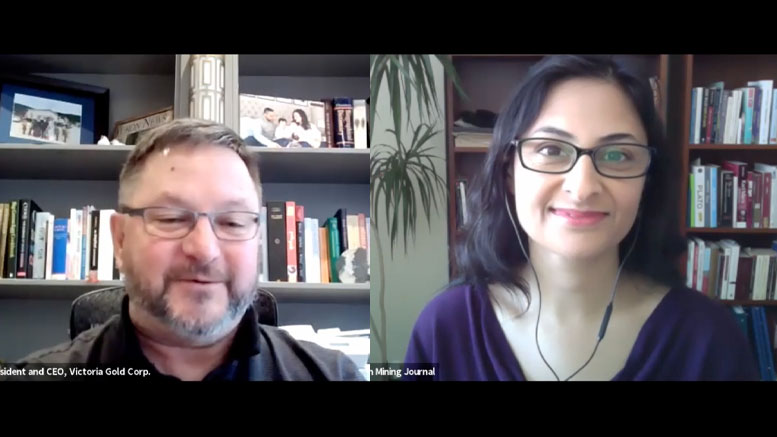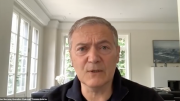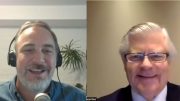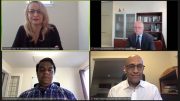Victoria Gold (TSXV: VGCX) commenced production at its Eagle heap-leach mine in the Yukon on July 1 – perhaps the only new gold mine in the world to launch in the midst of a global health crisis.
“It’s going reasonably well, but if I had my druthers, then we wouldn’t be ramping-up a new gold mine during a pandemic,” John McConnell, Victoria Gold’s president and chief executive, said during The Northern Miner’s Global Mining Symposium in November.
In an interview with Alisha Hiyate, editor-in-chief of the Canadian Mining Journal, McConnell said the company was able to keep everything on track despite the disruptions.
“We worked closely with the territorial government to ensure that we could maintain operations and put in a lot of protocols around social distancing on the job,” McConnell said. The company also switched its fly-in rotation schedule from two-weeks in/two-weeks out to four-weeks in/four-weeks out and now uses charter flights instead of scheduled flights.
The most challenging aspect was the closure of the Yukon border, which meant that anybody arriving from outside the territory had to self-isolate for two weeks in Whitehorse, McConnell said. However, a bubble was opened for the Yukon and B.C. on July 1, which helped significantly as about 35% of the company’s employees come from British Columbia. (In full operation, the mine will employ 350 to 400 people, about 25% of whom would come from First Nations communities.)
Like most other companies, Victoria Gold also had to rely on Zoom calls. “When you’re ramping-up, you really need support from vendors, and from March to June, we had no vendor support on-site because all of the vendors are located across the country and into the U.S.,” McConnell said. “So there were a lot of Zoom calls trying to trouble-shoot various aspects of the operation.”
In addition, Victoria Gold was able to work with government officials and the chief medical officer for the Yukon to develop protocols that would keep everybody safe and healthy at work, McConnell said, to “ensure that the communities were kept safe.”

John McConnell, president and CEO of Victoria Gold, and Tara Christie, president and CEO of Banyan Gold, at Victoria Gold’s Eagle mine in August 2019. Photo by Alistair Maitland Photography.
Disruptions from Covid-19 put Victoria Gold about 10% behind schedule, McConnell told Hiyate, but the company has now caught up and is in good shape for the first full year of production in 2021. At full capacity, the Eagle mine should produce about 200,000 oz. gold per year at all-in sustaining costs (AISCs) of US$774 per ounce.
McConnell described his first trip to the area in 2008. One of the company’s board members at the time, Hugh Agro, “suggested that we look at the Eagle deposit as he felt it had a lot of similar characteristics to Kinross Gold’s Fort Knox mine in Alaska,” McConnell said.
Both are located in the Tintina belt of rocks that run through the Yukon and into Alaska, and the geologies of both deposits are almost identical, according to McConnell. “Geologists looking at core drill samples from the two deposits probably wouldn’t be able to tell them apart.”
At the time, the project was owned by StrataGold, which Victoria Gold acquired in 2009.
In 2018, Victoria Gold entered into a $505 million construction financing package with Orion Mine Finance, Osisko Gold Royalties (TSX: OR; NYSE: OR), and Caterpillar Financial Services.
In addition to starting a mine in the middle of a pandemic, working in the Yukon presented its own unique set of difficulties, not least the weather. “There are challenges dealing with cold weather, and I always say that ‘Murphy’s [law is] alive and well in the mining business and he spends a lot of time north of 60 [degrees],’” he said. “If a pipe breaks in Mexico, you just fix it. If a pipe breaks in the Arctic, you’ve got a big popsicle.”
Soon after joining the company and moving to the Yukon, McConnell met and married his wife, Tara Christie. “I often refer to CEOs that live in Vancouver or Toronto as seagulls,” he said. “They fly in, they eat, they shit, and then fly out again, but I’m not that the kind of CEO. When I was with DeBeers, I moved to Yellowknife. It’s essential to have that personal interaction with politicians, regulators, and bureaucrats, and for them to know that you are part of their community.”
McConnell said that being active in the community and getting to know people is key, pointing out that his family spends the summer at a property it owns in Mayo, a village in the Yukon about 400 km north of Whitehorse.
The mining executive also talked about maintaining close ties with the local First Nations and how he developed a productive relationship with the Na-Cho Nyak Dun First Nation and its chief Simon Mervyn.
McConnell said the two have become good friends, and recalled the first time they met. “I phoned him and introduced myself as the new chief executive of Victoria Gold and asked if I could buy him lunch,” McConnell recalled. “We met for lunch and as soon as we sat down, he asked ‘what do you want?’ and I replied by saying, ‘nothing, I just wanted to buy you lunch and get to know you a little and to understand the issues facing the community.’”
Noting that Eagle is a heap-leach mine, Hiyate asked McConnell to comment on any environmental concerns that the Na-Cho Nyak Dun had around the use of cyanide at the mine, and how the company was able to ease their concerns.
McConnell said one way the company dealt with the issue was by taking regulators and community members to Alaska to visit Kinross Gold’s Fort Knox mine. “Once they had seen a large mining operation that also uses cyanide, we were able to show that it was safe to use, and this relieved their fears.”
In 2012, Victoria Gold started a charity called ‘Every Student. Everyday’ to improve student attendance at schools in the Yukon.
McConnell said that the charity was a “little self-serving,” as the company’s future employees will likely be Yukoners and the move was partly an attempt to improve the territory’s high rate of absenteeism and ensure that children remain in school. Seed money came from Victoria Gold, he said, and his wife manages the charity.
Looking ahead, McConnell described Victoria Gold’s plans for Eagle and its exploration upside.
“The company owns a large landholding in the Yukon, and it’s only in the last three years that we started stepping-out from Eagle to look at the regional potential,” he said. “We’ve identified around 12 or 13 targets for further exploration.”
Victoria Gold is now focused on an area about 13 km east of Eagle called Nugget, which McConnell said is another sizeable granodiorite intrusive with similar geological characteristics to the Eagle intrusive. The company trenched and drilled several preliminary holes in the area last year and drilled 35 holes this summer, which led to a new discovery at Nugget that contains many multiple-gram intercepts.
“It’s early days at Nugget, and we’ve got lots of work to do,” McConnell said, “but it looks like there could be another Eagle-type deposit out to the east of Eagle.”
View the full interview here:






Be the first to comment on "Victoria Gold’s John McConnell on launching a mine during a pandemic"